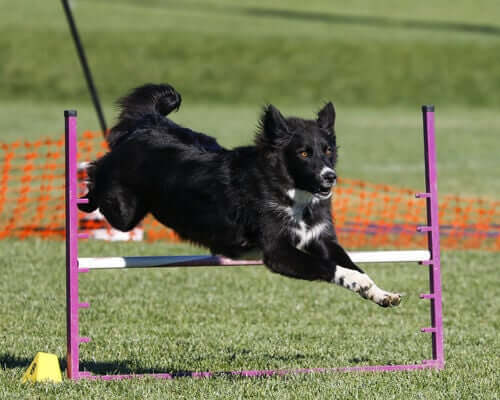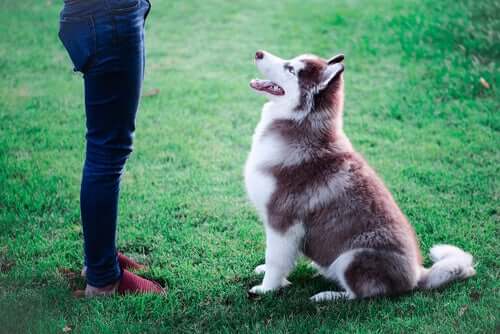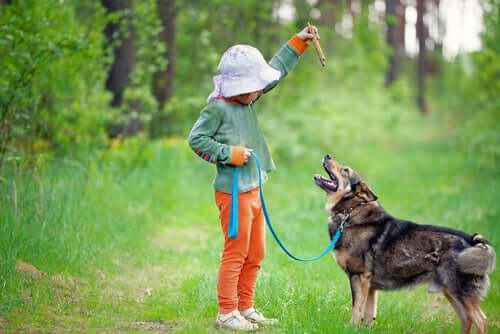Training Pets During Lockdown: Tips for Owners

Training your pets during lockdown can be an activity that offers long-term benefits, as long as owners know how to go about it. Would you like to know the keys to success? We’ll tell you all you need to know in the paragraphs below.
As we’ve said many times over the last weeks, lockdown is a great time to improve your relationship with your pets. In order to do so, you just need to use playtime and affection .
Training can help you improve communication with your pet and, what’s more, it will help you better understand several issues. And, of course, your dog will learn something new.
Training or education?
Before we go on, it’s important to keep in mind that training pets during lockdown isn’t the same thing as educating them. We’ll look at some of the reasons below.
- Training consists of teaching your dog new skills–what we call “tricks”. It’s about encouraging behaviors based on obedience. By means of positive reinforcement, a dog can learn to roll over, sit, shake hands, stay still, turn around, etc.
- Canine education is based on dogs learning to handle situations that arise in their everyday environment. In other words, it involves things like being able to go out for walks without problems and to have peaceful encounters with other dogs. At the same time, it’s teaching dogs how to stay home alone without becoming anxious, or how to be around other people, with or without their owner being present.

Training pets during quarantine: the benefits of positive reinforcement
Just like there are professionals to help with canine behavior problems, there are also professional trainers. And, of course, there are those that know how to do both.
The best way to go about teaching your dog something new is through positive reinforcement. Rewarding or reinforcing actions gives animals the reinforcement they need to repeat them. The reward doesn’t necessarily have to be food. In fact, affection, attention, and toys can also be great motivators.
By training our pets, we can reap a great number of benefits beyond simple obedience. These exercises facilitate communication with your pet in all types of situations, and reinforce various positive aspects:
- Basic obedience. Learning basic commands like “sit” or “still” is fundamental. It teaches dogs where they should be and how to improve their self-control. Other commands, like “heal”, help your dog learn to walk next to you when you’re out. And “come” for example, teaches your dog to come when you call it.
- Improved communication between owner and pet. Training pets during lockdown (or any time, for that matter) will help build the bond between you. You’ll better understand your dog, discover its weaknesses and preferences, and when your pet feels comfortable. In short, it’s a great tool for communication between owners and pets.
- It involves the entire family. Anyone in your household can offer positive reinforcement. Even the youngest members of your family can learn to reinforce your dog’s obedience and get involved in caring for your pet. In a time when external stimuli are lacking, this type of practice offers benefits to both children and animals.

Training pets during lockdown: tips
Learning requires your pet to make an effort as well. The energy that pets accumulate as a result of shortened walks and prolonged periods of time indoors is something you can use to your advantage. Just the same, training pets during lockdown will require owners to be clear on the following things.
1. Be patient
Training requires time and practice. Don’t become anxious if your dog doesn’t do what you want on the first few tries. Animals are autonomous and have their own desires and wishes, which is something we shouldn’t forget.
Dogs know how to interpret our facial expressions and recognize human emotions. Therefore, to help your dog learn, it’s best to transmit a sense of calm and firmness. There’s no point in scolding or yelling at your dog, and you should definitely refrain from becoming violent. If you do, you’ll only cause your pet to associate training with negative experiences.
2. Take advantage of the right moment
The speed at which an animal will learn to obey varies from one dog to the next. There are certain breeds that learn faster by nature. What’s more, you also need to take into account your dog’s mental state at the time you’re attempting to teach something new.
Both parties–you and your dog–need to be willing to interact. Forcing a tired dog to learn will only make the process frustrating for both of you.
3. Positive reinforcement
Reinforce positive results with something that motivates your dog enough to want to obtain the reward. However, be careful not to cause an obsession which will only distract your pet from learning. Food is the most popular reward of choice, but affection, games, and walks will also help your pet associate learning with reward.
4. Use body language
The language of signs and gestures is very visual for dogs. Although they can also come to understand words, it’s much easier for them to associate activities with gestures. In fact, there are specific gestures that facilitate learning different commands (sit, stay, come, fetch, roll over, etc). Over time, you’ll see that your dog is quicker to obey gestures than verbal commands.

Patience and respect, two important factors
As you’ve realized, the world of dog training is simple but requires an understanding of certain rules and concepts. Remember that, over the course of the entire process, owners must be sure to respect the needs and personal space of their pets. The goal is for your dog to learn and advance, not feel like it’s being punished.
If you’re both open to healthy interaction, training pets during lockdown can be a very beneficial process .
All cited sources were thoroughly reviewed by our team to ensure their quality, reliability, currency, and validity. The bibliography of this article was considered reliable and of academic or scientific accuracy.
- Hablaconellos. Educación y Adiestramiento Canino.
- Affinity pet-care. Adiestramiento canino en positivo. ¿Qué es y en qué consiste?
- Fundación Addinity. Los beneficios de adiestrar a un perro en positivo, 2007.
- Soyunperro. Cómo adiestrar un perro, 2018.